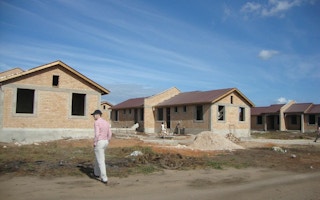Over seven thousand kilometres separate Singapore from Tanzania, and yet this distance did not deter Singaporean design practice GreenA Consultants to develop the first Green Mark-awarded housing project in Africa.
To continue reading, subscribe to Eco‑Business.
There's something for everyone. We offer a range of subscription plans.
- Access our stories and receive our Insights Weekly newsletter with the free EB Member plan.
- Unlock unlimited access to our content and archive with EB Circle.
- Publish your content with EB Premium.
Working with the United Nations Human Settlements Programme (UN Habitat) and Tanzania’s National Housing Corporation, the firm facilitated the sustainable urbanisation programme known as the Kigambuni Housing Estate. This completed project provides about 200 affordable, eco-friendly homes to the impoverished population of the city of Dar es Salaam, setting a template for future residential developments in the country’s drive to create an eco-city.
Dar es Salaam, which means ‘the abode of peace’ in English, aims to be a sustainable and economically progressive city like Singapore, with an inclusive society, said GreenA Consultants.
The national government of Tanzania has been collaborating with the UN Habitat to bring its people out of poverty through its Tanzania Development Vision 2025, part of which is focusing on those who live in unplanned areas.
In a 2010 UN Habitat report called “Citywide Action Plan for Upgrading Unplanned and Unserviced Settlements in Dar es Salaam”, Tanzania Prime Minister Mizengo Peter Kayanza Pinda said: “Dar es Salaam is by far the largest urban area in the country and whatever happens in the city has repercussions for the rest of the country. That 80 per cent of city residents live in unplanned and unserviced areas is a big challenge, not just to Dar es Salaam residents but also to general national welfare.”
“
These homes primarily have energy efficiency features based on a passive design concept or the use of the natural surroundings to create comfortable building conditions. Other green building elements are also incorporated to make the homes less impactful on the environment, long lasting, affordable and ideal for encouraging social responsibility.
The Kigambuni Housing Estate is a means to solve this problem, said GreenA Consultants. Tanzanians who migrated to the city in search of better opportunities yet became mired in poor living conditions will now have a chance to improve their lives.
Instead of residing in slums, they will have dignified homes that they can build themselves, so as to enrich their skills and improve their job prospects, the design consultancy explained.
In an email to Eco-Business, GreenA Consultants senior partner Farizan d’Avezac de Moran said that the Kigambuni Housing Estate is a mix of two- and three-bedroom houses ranging from 52 to 60 square meters in size. The development will also have a community park and a school.
These homes primarily have energy efficiency features based on a passive design concept or the use of the natural surroundings to create comfortable building conditions. Other green building elements are also incorporated to make the homes less impactful on the environment, long lasting, affordable and ideal for encouraging social responsibility.
One of the initial considerations for the Kigambuni Housing Estate is the climate and geographic conditions of the area. Since the “heat may sometimes be unforgiving in this East African country”, said the firm, they minimised the East-West façade or the home’s exposure to the sun by orienting it towards the right balance between solar shading, insulation and ventilation.
“Day lighting brings about warmth and creates an inviting ambience as opposed to artificial lighting – and the best part is that it reduces electricity bills too,” the firm added.
Saint Gobain glass windows are also used to reflect the sun’s heat and keep the interiors cool, and solar photovoltaic panels are included in the project development to generate clean energy, which will supply 8000 kilowatts per hour worth of energy to light up facilities and common areas for the entire year.
Cool roofs with high solar reflectivity are also installed to reduce the heat island effect, or the phenomenon describing higher temperatures in urban centres compared to rural areas.
Aside from energy-related concerns, the houses also feature a rainwater harvesting system since Tanzania is known to have scarce water supply. This will provide residents with access to clean potable water, eliminating the need to resort to water kiosks that oftentimes extort 50 to 650 per cent more than the official tariffs, said GreenA Consultants.
Another highlight of the estate is microclimatic landscaping, which will enable residents to grow gardens or their usual crops, since most Tanzanians rely on agriculture for their livelihood.
Through these green building features, the firm said the houses enable a “greater sense of overall well-being and vitality in the community, therefore, improving the quality of life”. It also empowers the Tanzanians to take responsibility of these homes, ensure its maintenance, and spread the word on living sustainably.
According to d’Avezac de Moran, Singapore’s Building and Construction Authority – the certification body that issues the Green Mark award – flew to Tanzania to assess these features and certify the project.
The firm became a part of the development project through their active involvement in promoting Energy Efficiency in Building in East Africa (EEBEA), which is under the UN Habitat, added d’Avezac de Moran.










